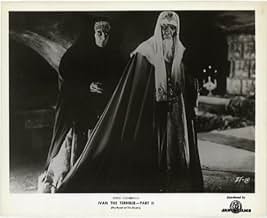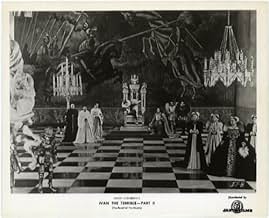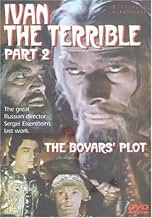IMDb रेटिंग
7.7/10
8.5 हज़ार
आपकी रेटिंग
अपनी भाषा में प्लॉट जोड़ेंAs Ivan the Terrible attempts to consolidate his power by establishing a personal army, his political rivals, the Russian boyars, plot to assassinate their Tsar.As Ivan the Terrible attempts to consolidate his power by establishing a personal army, his political rivals, the Russian boyars, plot to assassinate their Tsar.As Ivan the Terrible attempts to consolidate his power by establishing a personal army, his political rivals, the Russian boyars, plot to assassinate their Tsar.
- निर्देशक
- लेखक
- स्टार
- पुरस्कार
- कुल 1 नामांकन
Vsevolod Pudovkin
- Nikolay the Fanatic
- (as V.I. Pudovkin)
Ada Voytsik
- Elena Glinskaya, Ivan's Mother
- (as Ada Vojtsik)
Aleksandr Rumnev
- The Stranger
- (बिना क्रेडिट के)
Semyon Timoshenko
- Kaspar von Oldenbock, Livonian ambassador
- (बिना क्रेडिट के)
फ़ीचर्ड समीक्षाएं
10zetes
There is not a single criticism I could make for either Ivan the Terrible Film. They are perfect films, original, effective, and affecting. Perhaps the two best films ever made. If not, they're to be included on my list of totally invaluable films, with not a doubt in my mind.
II begins exactly where I ends. Ivan has consolidated his power in Moscow, at least with the people (though not with the nobles, or "boyars"). In fact, what power he has inspires jealousy and fear in the boyars.
Ivan I builds Ivan up as a noble character. We despise the boyars for their flagrant wealth and greed, and we like Ivan for supporting the people. His closest comrades seem like Homeric heroes.
Ivan II develops Ivan's character even further. He may have power, but he still feels alone on the throne. His two greatest friends have left him, one gone to religion and one to the enemy. His immediate underlings, perceived as heroes in Ivan I, have grown paranoid and powerful. They convince Ivan to execute left and right. The only route for the boyars is to conspire Ivan's death.
Ivan II leads up to one of the single greatest climax I can think of. To heighten the effect, for the first time, Eisenstein opted to shoot in color. And as masterful as he was with black and white, he is also with color. The juxtaposition of color with black and white is absolutely amazing.
The only problem with the film is no one's fault. Part II ends, open for the third installment. Alas, Sergei Eisenstein would die before its completion. We're lucky enough to have Ivan the Terrible Part II, for Stalin demanded that it not be released theatrically, believing Ivan to be a portrait of himself. Eisenstein, in fact, never had the chance to see it released theatrically, was never to hear the lavish praise from critics the world round. Here I praise it, hoping that in the next world possibly Eisenstein can know what masterworks he made.
II begins exactly where I ends. Ivan has consolidated his power in Moscow, at least with the people (though not with the nobles, or "boyars"). In fact, what power he has inspires jealousy and fear in the boyars.
Ivan I builds Ivan up as a noble character. We despise the boyars for their flagrant wealth and greed, and we like Ivan for supporting the people. His closest comrades seem like Homeric heroes.
Ivan II develops Ivan's character even further. He may have power, but he still feels alone on the throne. His two greatest friends have left him, one gone to religion and one to the enemy. His immediate underlings, perceived as heroes in Ivan I, have grown paranoid and powerful. They convince Ivan to execute left and right. The only route for the boyars is to conspire Ivan's death.
Ivan II leads up to one of the single greatest climax I can think of. To heighten the effect, for the first time, Eisenstein opted to shoot in color. And as masterful as he was with black and white, he is also with color. The juxtaposition of color with black and white is absolutely amazing.
The only problem with the film is no one's fault. Part II ends, open for the third installment. Alas, Sergei Eisenstein would die before its completion. We're lucky enough to have Ivan the Terrible Part II, for Stalin demanded that it not be released theatrically, believing Ivan to be a portrait of himself. Eisenstein, in fact, never had the chance to see it released theatrically, was never to hear the lavish praise from critics the world round. Here I praise it, hoping that in the next world possibly Eisenstein can know what masterworks he made.
While the first part of "Ivan the Terrible" is unique, stylized and powerful historical chronicle, second part is something more: poignant tragedy of authority. Since boyars poisoned Ivan's wife and his friends betrayed him, tsar remains in lonely. Oprichniki are only people he can trust. Ivan orders to kill some of boyars for instance, then Efrosinia Staricka (his aunt) sets plot against his life. One word gives atmosphere of this film: paranoia. Every character cares burden of fear - about his life, about his political business. Pervasive fear is delivered to us with unearthly dance of shadows, dramatic Prokofiev's score, haunting acting, poetic dialogs, monumental decorations and costumes. Everything looks very artificial but, paradoxically, not false; this film works with peerless emotional strength and brings as much true about authority as Shespeare's best works, being compatible to Maciavlelian theory of authority. There are only few films in history of cinema that so heavily consider problems of power (I'd mention "The Godfather, Part II" and Kurosawa's "Kagemusha" and "Ran" beside "Boyars Plot"). Don't miss. And if you decide to watch this film, I recommend: take great Criterion DVD box set which contains also first part and "Alexander Nevsky", another Eisenstein's sound masterpiece.
It's great art.Eisenstein can be compared to Michelangelo,no less.Needless to say,you've got to see part one -slightly inferior to this one,but what does it mean,when you' re watching the seventh art at the height of its terrible powers?-.This part focuses on the feud between Ivan and his aunt who tries to replace him by an effeminate imposter of her choice.Prokofiev music gives the feeling of watching an opera,the scenes in the cathedral recreate a mystery as it was in the Middle Ages as faithfully as you can wish.The peak of the movie remains the banquet,shot in color,thanks to spoils of war film.So stunning is Eisenstein's mastery of the picture that you can hardly exactly tell when the color returns to black and white (which for the final becomes a color in itself)Ivan's last soliloquy might seem aggressive and chauvinistic.But you've got to remember that the USSR were at war at the time ."Ivan" is timeless ,a monument that's as awesome today as it was for its -deleted,because of Stalin- 1958 release.
Ivan the Terrible Part II, the culmination of Eisenstein's career, is easily one of the most brilliant films of all time.
Nothing - repeat absolutely nothing - in this film is sub-par. The acting, especially the inhuman physical contortions of Nikolai Cherkasov as the Tsar himself, is uniformly excellent. As is to be expected from Eisenstein, the direction is perfect. Eisenstein's compositions create painterly tableaux that can be watched endlessly on pause (especially now that Criterion has issued both Ivans on DVD), allowing the audience to take in the full breadth of this man's genius. Additionally, unlike, for example, Alexander Nevsky or Strike, Ivan the Terrible Part II (and part I) benefits from a smoother pace and better editing, putting Eisenstein's theory of montage to its best use since Potemkin.
For me, however, what two key components of this film set it apart from its prequel and Eisenstein's earlier Potemkin and October.
Those components, as you can imagine, are its more pronounce political allegory and its color sequence towards the end.
Certainly October and Potemkin were highly politicized affairs, both celebrating the Communist victory in Russia. In Ivan the Terrible Part II (and to a lesser extent Part I), the audience bears witness to a moment of challenge wherein Eisenstein becomes critical of the course his country and its post-Lenin leaders have taken. As such, Ivan the Terrible becomes one of the bravest moments in film history and, for that alone, should be commended.
Brilliant as a political critique, the film also represents a dazzling demonstration of how color could be used in cinema. The colorized dance at the end of the film rivals and prefigures the technicolor explosion in Douglas Sirk's 1950s melodramas; furthermore, it reveals that color can be used to achieve specific effects. It does not have to mimic reality; rather it can be used artistically to enhance the mood and atmosphere of the film.
Taken as a whole, the two-part Ivan the Terrible is a masterpiece of Russian Cinema and should be required viewing for anyone with the slightest bit of interest in film. My preference lies with the second part, but both are fantastic moments in film history.
Nothing - repeat absolutely nothing - in this film is sub-par. The acting, especially the inhuman physical contortions of Nikolai Cherkasov as the Tsar himself, is uniformly excellent. As is to be expected from Eisenstein, the direction is perfect. Eisenstein's compositions create painterly tableaux that can be watched endlessly on pause (especially now that Criterion has issued both Ivans on DVD), allowing the audience to take in the full breadth of this man's genius. Additionally, unlike, for example, Alexander Nevsky or Strike, Ivan the Terrible Part II (and part I) benefits from a smoother pace and better editing, putting Eisenstein's theory of montage to its best use since Potemkin.
For me, however, what two key components of this film set it apart from its prequel and Eisenstein's earlier Potemkin and October.
Those components, as you can imagine, are its more pronounce political allegory and its color sequence towards the end.
Certainly October and Potemkin were highly politicized affairs, both celebrating the Communist victory in Russia. In Ivan the Terrible Part II (and to a lesser extent Part I), the audience bears witness to a moment of challenge wherein Eisenstein becomes critical of the course his country and its post-Lenin leaders have taken. As such, Ivan the Terrible becomes one of the bravest moments in film history and, for that alone, should be commended.
Brilliant as a political critique, the film also represents a dazzling demonstration of how color could be used in cinema. The colorized dance at the end of the film rivals and prefigures the technicolor explosion in Douglas Sirk's 1950s melodramas; furthermore, it reveals that color can be used to achieve specific effects. It does not have to mimic reality; rather it can be used artistically to enhance the mood and atmosphere of the film.
Taken as a whole, the two-part Ivan the Terrible is a masterpiece of Russian Cinema and should be required viewing for anyone with the slightest bit of interest in film. My preference lies with the second part, but both are fantastic moments in film history.
10matzoni
Like the first part of the movie "Boyarsky Zagovor" (Conspiracy of the Boyars)is indeed a film about Stalin (who was a great admirer of Ivan the IV.) and the (seem-to-be)mechanics of power itself. The ideology, which is acted out (or reflected?!) stays much the same: one people/one leader is the ideal and necessary state of the (russian) nation, enabling it to take up with the other nations ("the Germans")The terror on the boyars and the elimination of some of them reflects Stalin's paranoiac action on comrades, subaltern party-members with the help of the "oprichniki" (here: Beriya and consorts). For instance, once in the movie, Ivan makes 'one of his best friends' the metropolit of Moscow, but in the same sequence is persuaded by the oprichniki's leader to kill his relevant to make him scared of Ivan's power. Because of this illustration of paranoiac stalinist mechanism, I can't agree on the popular notion, that the second movie is not as good as the first. One more reason: the most startling child actor ever: Erik Pyryev as the young tsar, ordering the chief boyar to be lashed.
क्या आपको पता है
- ट्रिवियाThis film was withheld by Soviet authorities by order of Joseph Stalin, since this film, dealing with Ivan's slide into madness and the tyranny of the Oprichnina, did not properly mythologize Ivan IV Grozny to Stalin's satisfaction. It was not finally released until 10 years after the deaths of director Sergei Eisenstein and Stalin.
- गूफ़In the movie young Ivan IV is making a contract with the Livonian Brothers of the Sword. However it didn't exist since the 7th June 1238, almost 300 years before Ivan was born.
- भाव
Czar Ivan IV: From now on I will become the one you call me. I will become terrible.
- क्रेज़ी क्रेडिटThe main cast and their roles is read by the narrator with accompanied footage.
- कनेक्शनFeatured in The Secret Life of Sergei Eisenstein (1987)
टॉप पसंद
रेटिंग देने के लिए साइन-इन करें और वैयक्तिकृत सुझावों के लिए वॉचलिस्ट करें
विवरण
- रिलीज़ की तारीख़
- कंट्री ऑफ़ ओरिजिन
- भाषा
- इस रूप में भी जाना जाता है
- Ivan the Terrible, Part II: The Boyars' Plot
- फ़िल्माने की जगहें
- उत्पादन कंपनियां
- IMDbPro पर और कंपनी क्रेडिट देखें
बॉक्स ऑफ़िस
- दुनिया भर में सकल
- $1,655
- चलने की अवधि1 घंटा 28 मिनट
- रंग
- ध्वनि मिश्रण
- पक्ष अनुपात
- 1.37 : 1
इस पेज में योगदान दें
किसी बदलाव का सुझाव दें या अनुपलब्ध कॉन्टेंट जोड़ें

































